Introducing C. Reginald Dalby's
TALES OF FLITTERWICK HARBOUR
Written and illustrated by Railway Series artist, C Reginald Dalby in 1955, Tales of Flitterwick Harbour chronicles the life of this locale's nautical and human inhabitants such as Tubby the Tugboat.
The book featured four stories, not unlike the Railway Series. Here, you'll find character info and story summaries about this book that the author dedicated to his young daughter, Katheryn!

CHARACTERS OF FLITTERWICK HARBOUR
Meet the inhabitants of Flitterwick Harbour!
DINGER THE CLOCK
Our 'storyteller', Dinger is a turret-clock that is part of the Town Hall at the port of Flitterwick. At the time of the book's writing (1956), Dinger claims to be about 150 years old, and professes to be Big Ben's uncle (Yes, that Big Ben!). In turn, Dinger also has an uncle who is 200. One must not seek to become too literal-minded in terms of just how this lineage came about!
Located on a tower near the jetty, Dinger has four clock faces with a vantage point that enables him to see and know what's going on for miles around in every direction. He often notices Mr. Lordly peering at him with binoculars from across the harbour in order to set the time. The other Flitterwick Harbour characters regale him with the day's adventures when they are docked close to him at night. Another factoid is that Dinger never sleeps, which comes naturally to a clock, I suppose.
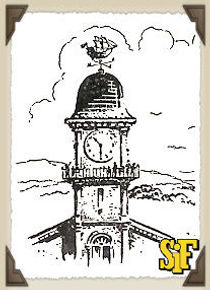
FLIP THE FERRY
In his role as a ferry-bridge, 'Flip' ferries traffic from the coast road on one side of the bay across to Flitterwick.
Flip is equipped with a steel ramp on each end that is raised/lowered in order to take on or discharge vehicles. Flip enjoys frightening Sandy the sand-barge with forecasts of rough weather, especially when Sandy is headed out to sea with a heavy load of mud and sand.
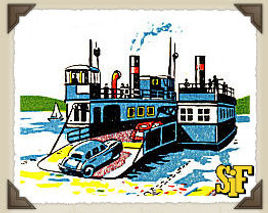
TUBBY THE TUGBOAT
The main character of ToFH, Tubby is a harbour tug-boat, and is described as being a very strong, cheerful and willing worker.
Tubby's services are always in great demand by cargo ship captains for safe passage into the harbour. The tug also enjoys singing to his charges as they are being towed in order to calm them down - especially Sandy.
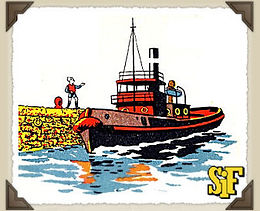
DONALD THE DREDGER
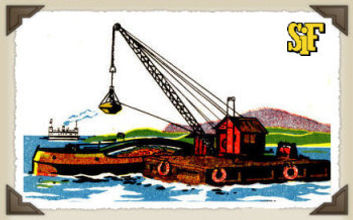
An engineless dredger equipped with a crane and large scoop. Donald is tasked with dredging the bottom of the harbour, and emptying each scoopful of mud and sand into Sandy the sand-barge. Donald relies on Tubby to be moved to and from work locations.
Once, having endured enough of Tubby's teasing about his malodorous stench (caused by the mud), Donald paid him out by dropping a load of mud straight into Tubby's funnel! Other than that one incident, Donald and Tubby are good friends.
SANDY THE SAND BARGE
An engineless sand-barge who is loaded to capacity with mud from Donald's dredging. Once full, Sandy is towed out to sea by Tubby, where he dumps his load of sand and mud into the deep ocean.
Sandy is often nervous about heading to sea with a full load, since his keel becomes very low to the water line. Sandy is also known to be a chronic complainer, with a rough and hoarse voice as if he had sand in his throat.
THE BUOYS
Strung outside the harbour in two long lines, the buoys are gossips, chatterers and love to joke around. They are prone to have bad-hair days, since they are often covered in seaweed. I guess that in the end, buoys will be buoys (sorry, we couldn't resist!)
THE PRIDE OF FLITTERWICK
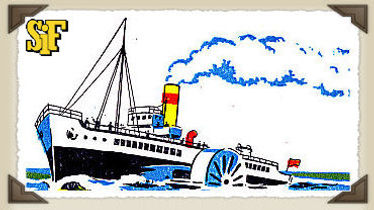
Also known as Percy Paddle, The Pride of Flitterwick is a pleasure steamer who commutes between Flitterwick and Swancombe. The ship is adorned in white, and crowned with a red-banded yellow funnel. Percy is conceited and rarely speaks with the other ships unless he is in an extremely good mood. Tubby envies Percy's looks and status.
HUMAN CHARACTERS
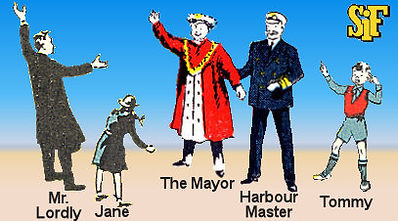
The Harbour Master: Described as Tubby's real boss (akin to the Fat Controller's relationship is to his engines.)
Tubby's Captain: A peripheral character in in the stories.
Tommy: Tommy is the son of Tubby’s captain, and has a reputation for playing tricks.
The Mayor: Naturally, the Mayor of the town of Flitterwick.
Mr. Lordly: A very proud, vain and wealthy man living on the other side of the harbour. He sets all of the clocks in his house to Dinger's time. He's a married father of a nine-year-old daughter named Jane. He is especially proud of his shiny new car. An impatient man who is always in a hurry, Lordly does not have a fondness for queues.
TALES OF FLITTERWICK HARBOUR
STORY REVIEWS
BY J. GRATTON
FLITTERWICK HARBOUR
The first story is an introduction of sorts to the main characters: Dinger, Flip, Sandy, Donald, and of course Tubby (see character profiles above)
TUBBY TO THE RESCUE
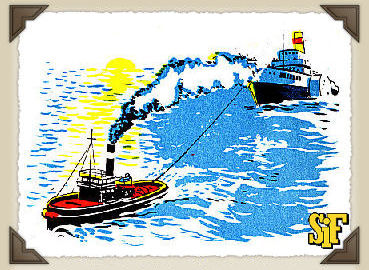
Tubby is dispatched by the Harbour Master to rescue a stranded Percy, but in his haste and pride to do so, forgets the tow-ropes! Too late to turn back, Flip lends him the necessary equipment. Once rescued, (to the adulation of Percy’s Passengers), Percy’s captain orders Tubby's captain to cast off the tow, lest someone sees them being towed into Flitterwick by a lowly tugboat. The demand is ignored.
As they arrive into the harbour, the other ships provide a rousing welcome with their horns and sirens, whilst the crowds assembled on the jetty, including the mayor, cheer wildly. Percy’s grateful passengers make a collection which raises enough money to have Tubby repainted.
THE PROUD GENTLEMAN
AKA. MR LORDLY GOES FISHING
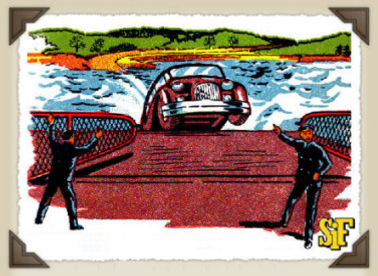
Mr. Lordly is having a very bad day in which everything seems to be conspiring against him. He cuts himself whilst shaving, he burns his tongue drinking hot coffee, his daughter Jane dawdles causing him to be six minutes late.
His coat is caught in the car door once he's on the ferry, then his hat is blown into the water. When he forgets to set his car's brake, Mr. Lordly's bad luck culminates with his car going overboard into the sea during the crossing. With the help of Flip’s crew and passengers, the car is eventually recovered, fish swimming about inside and all, much to a recalcitrant Mr. Lordly’s delight.
FIREWORKS
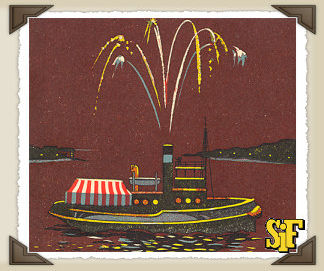
Tubby wishes that he could participate in Flitterwick Harbour's annual Regatta, especially to watch the evening's fireworks display. Thanks to Tommy, Tubby is permitted to be part of the Regatta – as a tea tent, on the condition that he is ready to work if called upon. As luck would have it, Tubby is sent out to retrieve a sailing ship. Because he is dressed as a tea tent, Tubby suffers through relentless teasing. He returns to the harbour just as the last fireworks rocket's glare flickers out, and is very disappointed to have missed the show.
Seeing his friend sad, Tommy later sneaks aboard and dumps a collection of fireworks into Tubby’s funnel in order to cheer him up. The spectacular and noisy results rouses the harbour's citizens from their sleep. The just-awakened Harbour Master is furious, with Tubby’s Captain promising corporal punishment against Tommy. Tubby intervenes to claim that the fireworks actually did him some good by cleansing his funnel of accumulated soot. All is forgiven, and so ends the last story of the book.
OVERALL IMPRESSIONS
Tales of Flitterwick Harbour was written in 1955, one year before C R Dalby left the Railway Series. Sadly, this was this new author's first and final foray into children's literature.
What surprised me most about this one-and-only volume were Dalby’s illustrations. Before reading ToFH, I fully expected to see vivid color illustrations on par with those Dalby had drawn for the Railway Series. Instead, the artwork was inked in black and white, and when colors were used, they were solid brown, yellow, red, black and blue. Accustomed as I was to the rich hues of his Railway Series work, these were typical for children's storybooks from the period and printing process used to keep production costs down.
Another interesting observation is that none of the mechanical characters were drawn having 'faces'. The only hints of anthromorphism are seen in the illustrations of Tubby in 'Fireworks' - where Tubby appears to have 'irises' in his cabin's fore portholes, and in the seemingly forlorn look of Mr. Lordly's car as it slips into the sea in 'The Proud Gentleman'.
As for Reginald Dalby's writing style, the stories could be easily read by a parent to a younger child, and Dalby interspersed his writing with his characters audibly expressing themselves in their own mechanical way with bells and whistles. The author also included a few short songs, undoubtedly added to liven up the storytelling as seen from this verse excerpt from Tubby's Song:
I'd rather be a little boat
And Sail the ocean wide.
And never sink but keep afloat
With Sandy by my side.
The interaction between the characters is also charming. There's this cute exchange between Tubby and Tommy in Fireworks abridged below:
"We must both have a very special think," said Tommy...
"That is a very good idea, Tommy," said Tubby. "We'll have two separate thinks."
So they were both very quiet, having a special think.
"I've thinked of something," said Tommy, and then, "No, that wouldn't do."
"And I've thinked of something," said Tubby, "and that won't do either."
Having read Tales of Flitterwick Harbour, I can say that I have a greater appreciation for Dalby's artistic contribution to the Railway Series. Despite the technical errors that sometimes crept into his illustrations, the vivid artwork undoubtedly contributed to the success of the early RWS volumes, and set the bar for future artists.
A quaint little book with entertaining stories, the map drawn by Dalby found in the cover's endpapers make me wonder whether additional stories were planned. Smugglers' Island, the Boatbuilders' Yards, Lilliford, Minister Regis all offered a promise of potential storylines, locales and characters.
In the end, Tales of Flitterwick Harbour was our first and last glimpse into Dalby's imagined world. Had the stories been illustrated in the same genre and quality as his work on the Railway Series, perhaps – just perhaps the book would not have faded away into obscurity.
But then again, perhaps ToFH isn't gone forever. With fan-fiction, Flitterwick Harbour may just be revisited someday - who knows, one of this fansite's many visitors may be inspired to take us there!
C. REGINALD DALBY'S MAP OF FLITTERWICK HARBOUR
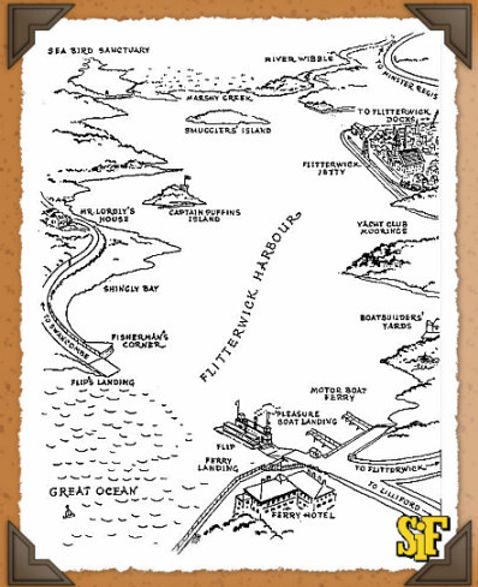
Were the landmarks depicted on this map to be used for future story settings?
TALES OF FLITTERWICK HARBOUR
STORY REVIEWS
BY J. GRATTON
FLITTERWICK HARBOUR
The first story is an introduction of sorts to the main characters: Dinger, Flip, Sandy, Donald, and of course Tubby (see character profiles).
TUBBY TO THE RESCUE

Tubby is dispatched by the Harbour Master to rescue a stranded Percy, but in his haste and pride to do so, forgets the tow-ropes! Too late to turn back, Flip lends him the necessary equipment. Once rescued, (to the adulation of Percy’s Passengers), Percy’s captain orders Tubby's captain to cast off the tow, lest someone sees them being towed into Flitterwick by a lowly tugboat. The demand is ignored.
As they arrive into the harbour, the other ships provide a rousing welcome with their horns and sirens, whilst the crowds assembled on the jetty, including the mayor, cheer wildly. Percy’s grateful passengers make a collection which raises enough money to have Tubby repainted.
TUBBY TO THE RESCUE

Tubby is dispatched by the Harbour Master to rescue a stranded Percy, but in his haste and pride to do so, forgets the tow-ropes! Too late to turn back, Flip lends him the necessary equipment. Once rescued, (to the adulation of Percy’s Passengers), Percy’s captain orders Tubby's captain to cast off the tow, lest someone sees them being towed into Flitterwick by a lowly tugboat. The demand is ignored.
As they arrive into the harbour, the other ships provide a rousing welcome with their horns and sirens, whilst the crowds assembled on the jetty, including the mayor, cheer wildly. Percy’s grateful passengers make a collection which raises enough money to have Tubby repainted.
THE PROUD GENTLEMAN
AKA. MR LORDLY GOES FISHING

Mr. Lordly is having a very bad day in which everything seems to be conspiring against him. He cuts himself whilst shaving, he burns his tongue drinking hot coffee, his daughter Jane dawdles causing him to be six minutes late.
His coat is caught in the car door once he's on the ferry, then his hat is blown into the water. When he forgets to set his car's brake, Mr. Lordly's bad luck culminates with his car going overboard into the sea during the crossing. With the help of Flip’s crew and passengers, the car is eventually recovered, fish swimming about inside and all, much to a recalcitrant Mr. Lordly’s delight.
THE PROUD GENTLEMAN
AKA. MR LORDLY GOES FISHING

Mr. Lordly is having a very bad day in which everything seems to be conspiring against him. He cuts himself whilst shaving, he burns his tongue drinking hot coffee, his daughter Jane dawdles causing him to be six minutes late.
His coat is caught in the car door once he's on the ferry, then his hat is blown into the water. When he forgets to set his car's brake, Mr. Lordly's bad luck culminates with his car going overboard into the sea during the crossing. With the help of Flip’s crew and passengers, the car is eventually recovered, fish swimming about inside and all, much to a recalcitrant Mr. Lordly’s delight.
FIREWORKS

Tubby wishes that he could participate in Flitterwick Harbour's annual Regatta, especially to watch the evening's fireworks display. Thanks to Tommy, Tubby is permitted to be part of the Regatta – as a tea tent, on the condition that he is ready to work if called upon. As luck would have it, Tubby is sent out to retrieve a sailing ship. Because he is dressed as a tea tent, Tubby suffers through relentless teasing. He returns to the harbour just as the last fireworks rocket's glare flickers out, and is very disappointed to have missed the show.
Seeing his friend sad, Tommy later sneaks aboard and dumps a collection of fireworks into Tubby’s funnel in order to cheer him up. The spectacular and noisy results rouses the harbour's citizens from their sleep. The just-awakened Harbour Master is furious, with Tubby’s Captain promising corporal punishment against Tommy. Tubby intervenes to claim that the fireworks actually did him some good by cleansing his funnel of accumulated soot. All is forgiven, and so ends the last story of the book.
FIREWORKS

Tubby wishes that he could participate in Flitterwick Harbour's annual Regatta, especially to watch the evening's fireworks display. Thanks to Tommy, Tubby is permitted to be part of the Regatta – as a tea tent, on the condition that he is ready to work if called upon. As luck would have it, Tubby is sent out to retrieve a sailing ship. Because he is dressed as a tea tent, Tubby suffers through relentless teasing. He returns to the harbour just as the last fireworks rocket's glare flickers out, and is very disappointed to have missed the show.
Seeing his friend sad, Tommy later sneaks aboard and dumps a collection of fireworks into Tubby’s funnel in order to cheer him up. The spectacular and noisy results rouses the harbour's citizens from their sleep. The just-awakened Harbour Master is furious, with Tubby’s Captain promising corporal punishment against Tommy. Tubby intervenes to claim that the fireworks actually did him some good by cleansing his funnel of accumulated soot. All is forgiven, and so ends the last story of the book.
JIM'S OVERALL IMPRESSIONS
Tales of Flitterwick Harbour was written in 1955, one year before C R Dalby left the Railway Series. Sadly, this was this new author's first and final foray into children's literature.
What surprised me most about this one-and-only volume were Dalby’s illustrations. Before reading ToFH, I fully expected to see vivid color illustrations on par with those Dalby had drawn for the Railway Series. Instead, the artwork was inked in black and white, and when colors were used, they were solid brown, yellow, red, black and blue. Accustomed as I was to the rich hues of his Railway Series work, these were typical for children's storybooks from the period and printing process used to keep production costs down.
Another interesting observation is that none of the mechanical characters were drawn having 'faces'. The only hints of anthromorphism are seen in the illustrations of Tubby in 'Fireworks' - where Tubby appears to have 'irises' in his cabin's fore portholes, and in the seemingly forlorn look of Mr. Lordly's car as it slips into the sea in 'The Proud Gentleman'.
As for Reginald Dalby's writing style, the stories could be easily read by a parent to a younger child, and Dalby interspersed his writing with his characters audibly expressing themselves in their own mechanical way with bells and whistles. The author also included a few short songs, undoubtedly added to liven up the storytelling as seen from this verse excerpt from Tubby's Song:
I'd rather be a little boat
And Sail the ocean wide.
And never sink but keep afloat
With Sandy by my side.
The interaction between the characters is also charming. There's this cute exchange between Tubby and Tommy in Fireworks abridged below:
"We must both have a very special think," said Tommy...
"That is a very good idea, Tommy," said Tubby. "We'll have two separate thinks."
So they were both very quiet, having a special think.
"I've thinked of something," said Tommy, and then, "No, that wouldn't do."
"And I've thinked of something," said Tubby, "and that won't do either."
Having read Tales of Flitterwick Harbour, I can say that I have a greater appreciation for Dalby's artistic contribution to the Railway Series. Despite the technical errors that sometimes crept into his illustrations, the vivid artwork undoubtedly contributed to the success of the early RWS volumes, and set the bar for future artists.
A quaint little book with entertaining stories, the map drawn by Dalby found in the cover's endpapers make me wonder whether additional stories were planned. Smugglers' Island, the Boatbuilders' Yards, Lilliford, Minister Regis all offered a promise of potential storylines, locales and characters.
In the end, Tales of Flitterwick Harbour was our first and last glimpse into Dalby's imagined world. Had the stories been illustrated in the same genre and quality as his work on the Railway Series, perhaps – just perhaps the book would not have faded away into obscurity.
But then again, perhaps ToFH isn't gone forever. With fan-fiction, Flitterwick Harbour may just be revisited someday - who knows, one of this fansite's many visitors may be inspired to take us there! ;-)
JIM'S OVERALL IMPRESSIONS
Tales of Flitterwick Harbour was written in 1955, one year before C R Dalby left the Railway Series. Sadly, this was this new author's first and final foray into children's literature.
What surprised me most about this one-and-only volume were Dalby’s illustrations. Before reading ToFH, I fully expected to see vivid color illustrations on par with those Dalby had drawn for the Railway Series. Instead, the artwork was inked in black and white, and when colors were used, they were solid brown, yellow, red, black and blue. Accustomed as I was to the rich hues of his Railway Series work, these were typical for children's storybooks from the period and printing process used to keep production costs down.
Another interesting observation is that none of the mechanical characters were drawn having 'faces'. The only hints of anthromorphism are seen in the illustrations of Tubby in 'Fireworks' - where Tubby appears to have 'irises' in his cabin's fore portholes, and in the seemingly forlorn look of Mr. Lordly's car as it slips into the sea in 'The Proud Gentleman'.
As for Reginald Dalby's writing style, the stories could be easily read by a parent to a younger child, and Dalby interspersed his writing with his characters audibly expressing themselves in their own mechanical way with bells and whistles. The author also included a few short songs, undoubtedly added to liven up the storytelling as seen from this verse excerpt from Tubby's Song:
I'd rather be a little boat
And Sail the ocean wide.
And never sink but keep afloat
With Sandy by my side.
The interaction between the characters is also charming. There's this cute exchange between Tubby and Tommy in Fireworks abridged below:
"We must both have a very special think," said Tommy...
"That is a very good idea, Tommy," said Tubby. "We'll have two separate thinks."
So they were both very quiet, having a special think.
"I've thinked of something," said Tommy, and then, "No, that wouldn't do."
"And I've thinked of something," said Tubby, "and that won't do either."
Having read Tales of Flitterwick Harbour, I can say that I have a greater appreciation for Dalby's artistic contribution to the Railway Series. Despite the technical errors that sometimes crept into his illustrations, the vivid artwork undoubtedly contributed to the success of the early RWS volumes, and set the bar for future artists.
A quaint little book with entertaining stories, the map drawn by Dalby found in the cover's endpapers make me wonder whether additional stories were planned. Smugglers' Island, the Boatbuilders' Yards, Lilliford, Minister Regis all offered a promise of potential storylines, locales and characters.
In the end, Tales of Flitterwick Harbour was our first and last glimpse into Dalby's imagined world. Had the stories been illustrated in the same genre and quality as his work on the Railway Series, perhaps – just perhaps the book would not have faded away into obscurity.
But then again, perhaps ToFH isn't gone forever. With fan-fiction, Flitterwick Harbour may just be revisited someday - who knows, one of this fansite's many visitors may be inspired to take us there! ;-)
C. REGINALD DALBY'S MAP OF FLITTERWICK HARBOUR

Were the landmarks depicted on the map to be used for future story settings?
C. REGINALD DALBY'S MAP OF FLITTERWICK HARBOUR

Were the landmarks depicted on the map to be used for future story settings?
RELATED LINKS
Read SiF's fascinating interview with C. Reginald Dalby's daughter, Kathryn Holland






